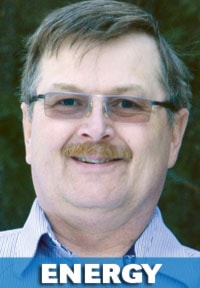Storage of energy is the holy grail of alternate energy systems.
An estimated 89 petawatts (1015 watts) of energy reaches the earth’s surface from the sun, more energy in one hour than the world uses in one year.
The energy that reaches the earth’s surface in six months is greater than what could ever be attained from all the coal, oil, natural gas, and uranium the earth contains.
If we can figure out how to store a portion of this energy abundance, energy shortages would become a thing of the past.
In 1982, the U.S. Department of Energy worked on thermal storage technology with a project called Solar One. It used mirrors deployed around a tower to focus light on a receiver, imparting heat to a high temperature heat transfer fluid which then was used to produce steam in a boiler.
Later upgraded and renamed Solar Two, its reflective array capacity was increased and it was adapted to use molten salt, ( 60% sodium nitrate and 40% potassium nitrate), for heat storage when the sun went down. The experiment was decommissioned in 2009.
Presently this technology is being used in Spain in a 19.9 MW power plant called Gemasolar. Commissioned in 2011 it has the capacity to supply 27500 homes with its 110 GWh per year output.
It is the use of molten salt which allows the production of electricity when the sun goes down on overcast days.
The molten salt has the ability to store more heat for a longer period of time than oil, with temperatures typically in the 560°C range.
Thermal transfer technology allows the plant to provide electricity for 15 hours with no sun.
Solar thermal plants are scatted around the world with 44 operational plants as of 2011 producing some 1.17 Gigawatts. There are another 28 plants under construction with a projected capacity of 2.47 Gigawatts.
Spain has some 25 operational plants and another 12 under construction.
These solar thermal plants range from power towers and solar concentrators, to parabolic trough designs, Fresnel reflectors, dish Sterling engine, and ISCC.
ISCC (integrated solar combined cycle) use solar and turbine power for continuous electrical output.
Canada as of yet has not jumped into the game, but a company in Saskatoon has developed a system in which their custom receiver / reflectors can heat the proprietary thermal fluid, which they also developed, to an impressive 850°C.
The thermal fluid is stored in insulated tanks where the heat is later used to provide for the continuous generation of electricity.
Their system designs range from 10 to 40kW small scale solar Stirling engine units, to 500 megawatt steam turbine power plants. It is the development of the 850°C capability that allows the system to rival conventional power generation systems.
Thermal storage for electrical generation is just one technological advance to energy independence.
Further development is needed, but our quest has scarcely started. Liken it to a comparison between Henry Ford’s Quadricycle circa 1896, and your vehicle today; technology perpetually progresses.
Lorne Oja is an energy consultant, power engineer and a partner in a company that installs solar panels, wind turbines and energy control products in Central Alberta. He built his first off-grid home in 2003. His column appears every second Friday in the Advocate. Contact him at: lorne@solartechnical.ca.
